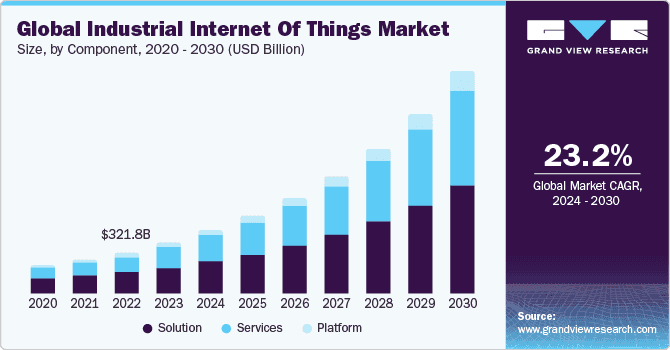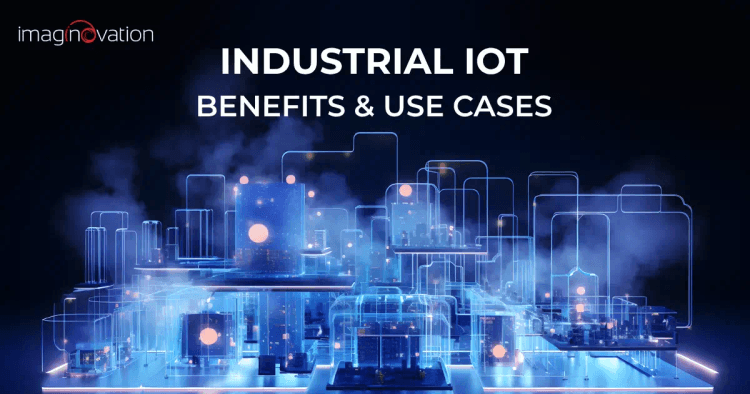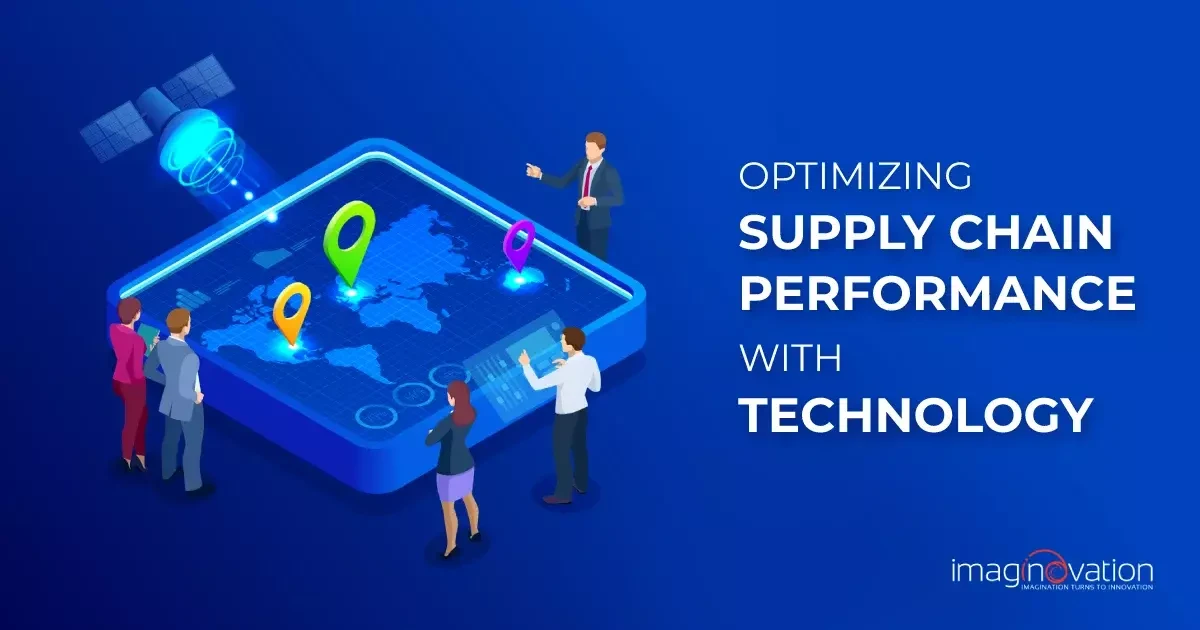IIoT is poised to upgrade every part of the manufacturing landscape. The IIoT technology is worth exploring because of its outstanding success stories.
What's more, the global IIoT market size is projected to touch USD 106.1 billion by 2026, and it's no surprise! IIoT is the next level of IoT technology that has completely revolutionized the manufacturing landscape.
IIoT technology has a significant impact on modern manufacturing. It has helped businesses improve efficiency, streamline maintenance, monitor assets and more. That's why, it's imperative to embrace IIoT to remain competitive in the market.
Tag along! We will be demystifying the benefits, use cases, and implementation challenges of IIoT.
What is IIoT Technology?
IoT technologies exist all around us, and you're right - IIoT technology can be a nebulous term. Hence, it's vital to understand the essence of IIoT.
Many technological advances have been made. Similar to the Connected Factory and Industry 4.0 (I4.0), IIoT means that organizations can connect to many different devices. The main focus of this revolutionary technology is optimizing industrial operations and processes through data-driven insights.
In short, IIoT refers to the network of interconnected systems, devices, and sensors in industrial settings. It enables real-time data monitoring, predictive analytics, and remote management.
IIoT solutions offer many benefits for businesses, including streamlining operations, boosting productivity, and driving innovation across industries. It's no wonder that the technology is experiencing phenomenal growth. Experts predict a prosperous future for IIoT technology and anticipate a global market value of $3.3 trillion by 2030.

Image 1: Industrial IoT market size worldwide from 2020 to 2030 (Source)
IIoT growth and transformation are having a positive impact on industries, guaranteeing phenomenal success.
Difference Between IoT and IIoT
Imagine you have a cool fitness watch and tracker, let's say a Garmin Venu 3S or Samsung Galaxy Watch 6. The device can record and monitor your daily burned calories, heart rate, step count, and sleep patterns based on the sensors. Enter IoT! With the technology, the data can now be sent to your smartphone or computer, and you can track your progress over time, set goals, and even share your achievements with friends or healthcare providers.
What is IoT? IoT stands for the Internet of Things. It can connect everyday devices to the Internet as they are embedded with sensors, software, and other technologies, allowing them to connect, exchange, and process data. These objects span from everyday items, including wearable health devices, household appliances and vehicles to industrial machines and infrastructure integrands.
The primary goal of IoT is to transform ordinary objects into smart devices. Thus allowing them to interact with humans, other devices, and the environment in many distinctive ways. It can potentially revolutionize industries, including healthcare, agriculture, manufacturing, transportation, and smart cities. Ultimately, it can enhance our quality of life, improve safety and security, and drive significant economic growth.
IIoT stands for Industrial Internet of Things, and the technology focuses specifically on applying IoT technology in industrial settings, such as manufacturing, energy, transportation, and utilities. In short, it is a subset of IoT focusing on the industrial sector.
Imagine a factory that produces automotive parts. This factory is equipped with various machines and equipment, such as robotic arms, conveyor belts, and CNC machines, which are essential for manufacturing. These machines are connected to a network and outfitted with sensors that monitor temperature, vibration, pressure, and energy consumption. With IIoT, the factory can implement a predictive maintenance system.
IIoT leverages technologies such as big data, machine learning (ML), smart sensors, and M2M communication to streamline various processes. The technology helps improve operational efficiency, productivity, and safety in industries.
While IoT and IIoT share some common principles, the differences are noteworthy. IoT focuses on consumer usage and improving life quality, whereas IIoT is more applicable to industrial applications and focuses on boosting efficiency and productivity in industrial settings.
Here is a quick snapshot highlighting the critical differences between IoT and IIoT.
| Aspect |
IIoT |
IoT |
|---|---|---|
| Scope and Scale |
Applies to the industrial sector and involves large-scale M2M communication and automation of complex industrial processes |
Everyday devices and consumer-focused applications |
| Environment and use cases |
Industrial plants, [warehouses](https://imaginovation.net/blog/using-blockchain-to-build-smart-warehouses/), and factories Use cases: Predictive maintenance, Manufacturing automation and optimization, Energy management and smart grids, Supply chain and logistics management |
Retail, home, office Use cases: smart homes, connected vehicles, smart cities, wearable health devices |
| Complexity |
IIoT involves complex operations and high-precision |
IoT devices can work on tasks such as monitoring fitness activities or tweaking room temperature |
| Connectivity |
Uses specialized industrial communication protocols (e.g., Modbus, OPC-UA, Profinet) |
Uses common communication protocols like Wi-Fi, Zigbee, Bluetooth, Broadband, |
| Data volume |
High |
Typically, moderate to high |
| Security Protocols |
Need to implement advanced and rigorous security protocols |
Need not be very stringent |
| Programmability |
IIoT systems are both highly programmable and customizable |
IoT devices come with pre-programmed functionalities |
| Interoperability |
Integrates with co-existing legacy operating systems |
Functionally independent |
Real-World Applications and Use Cases of IIoT
IIoT is revolutionizing the industry, and it is the driving force behind the "smart factory" concept. IIoT has a long list of use cases that facilitate business growth, and here's a peek.
1. Smart Manufacturing and Factory
IIoT can help to make manufacturing and factories smarter. Using the technology, factories can link their machines and other requisite industrial components. Gadgets and parts can be set with sensors, which enable them to share data and communicate in real-time. The insights further help to monitor output, improve workflow and predict repairs.
Thus, IIoT allows predictive maintenance, real-time monitoring, and automation. It's no surprise that the manufacturing sector uses the most significant part of IIoT, approximately 34%.
Here's a good example: sensors when attached to machinery can help collate data about the manufacturing process. Further, AI and ML algorithms can evaluate the information at a centralized IIoT platform. The insights can help identify the industrial bottlenecks and offer lucid solutions. The tweaks can help to boost productivity and achieve higher quality standards.
With 85% of US manufacturers currently implementing or planning to implement IIoT solutions, the statistics reiterate how the technology is fit-for-future. The revolutionary approach has helped boost new business opportunities, and IIoT is assisting with the seismic shift.
2. Energy and Utilities
With the global demand for energy expected to grow by about 25% by 2040, many business leaders are open to adopting IIoT solutions. The technology and its application can help manage energy production and distribution by improving the utilities managing the power grids.
Yet another benefit of IIoT to our environment and oil and gas companies is moderating conditions that are risky to the environment. With smart devices and equipment lessening production issues and accidents, specialized applications can help track and monitor the environmental impact of the production process.
Here are some excellent examples of how IIoT can impact utilities and bring in massive amounts of new data sources: smart meters, load breakers, re-closers, meter concentrators, and secondary substations.
IIoT solutions, using Advanced Metering Infrastructure (AMI), have transformed electric utilities. Further, sensor technology, big data and analytics are now used to optimize operations, such as efficiently balancing supply and demand as customers connect to a smart grid.
3. Automotive
IIoT in the automobile industry plays a phenomenal role, leading to a new era of connected and intelligent vehicles. According to a study, the total IIoT for Automotive Market revenue is expected to grow at 33% from 2024 to 2030, reaching nearly US$ 26.63 Billion.
While IIoT solutions can help with functional efficiencies, they can also solve critical data management problems. IIoT technologies use scales, sensors, and gauges. The network of such components helps collate data and leverage cloud-based manufacturing optimization software, transforming it into actionable insights.
A huge benefit is that predictive quality control analytics, it is easy to scrap or even rework parts. Thus, any faulty parts can be preempted. Automakers must take a multipronged approach to create relevant business models and make the most of opportunities.
4. Transportation and Logistics
Any transport and logistics company implementing IIoT solutions will find benefits spanning from enhancing overall supply chain visibility to predictive maintenance and smart logistics. It has also helped reduce pilferage with the help of sensors, as it is easy to identify and alert stakeholders of fuel theft or any unusual usage patterns.
Using IIoT devices, businesses can monitor vehicles, track shipments, and optimize routes based on traffic and weather conditions. Thus, logistics companies can implement IIoT to track fleets of trucks in real-time, enabling predictive maintenance, improved route planning, and optimized fuel consumption. Numerous features like delivery, scheduling, and placement are being automated using IIoT in transportation and logistics.
5. Healthcare
IIoT in healthcare is standing at the forefront of the digital revolution. It is poised to usher in a new era of reduced medical errors, improved patient care, and better healthcare outcomes.
Devices with IIoT functions and applications, like glucose monitors, medical sensors, medical imaging equipment, EKG monitors, smart pill dispensers, blockchain-enabled systems, heart health monitors, and tools, for users can collect data and support healthcare providers in their studies.
Remote monitoring of patients has become seamless with IIoT because medical data and information can be accessed easily. Thus, critical treatment trends can be made up-to-date, which helps healthcare professionals make informed decisions faster.
6. Retail and Supply Chain

IIoT in supply chain management has helped improve operational efficiency, enhance visibility and tracking, enable data-driven decision-making, and foster innovation and collaboration.
IIoT solutions have empowered supply chain managers, with insights into their products real-time location, supplier and stock information. With the use of IIoT-enabled devices such as beacons and RFID tags, it is easy to track inventory levels. Plus, it is helpful to monitor product movement and optimize store layouts for improved customer engagement and sales.
Further, IIoT devices can also be programmed for real-time events, offering built-in contingency planning that can help businesses with a competitive and resilient edge.
7. Smart Agriculture
The agriculture industry will undoubtedly benefit from outfitting IIoT. IIoT sensors empower farmers with critical data. With the data and insights, the farmers can accurately predict rainfall, soil nutrition levels, and crop yields. They can also proactively work on pest infestations and crop failures.
It is exciting to watch farming practices develop, backed by the continuous evolution of IIoT in agriculture. The farmers will benefit from improved connectivity resulting in enhanced productivity. In light of the niche technology, many traditional farm equipment manufacturers are willing to switch to better connectivity and other advanced smart manufacturing techniques.
8. Cybersecurity
Most businesses are vulnerable to cyber threats, and any compromise could have severe consequences for them. IIoT in cybersecurity can potentially maintain the security and integrity of industrial systems and data.
IIoT solutions help with continuous monitoring of networks and can detect unusual patterns of activity that might indicate a cyber attack. Further, with AI and ML algorithms, IIoT systems can track and monitor device behavior to identify anomalies and potential security breaches. With continuous vigilance and real-time updates and alerts, organizations can significantly enhance security and protect against cyber threats.
9. Environmental Monitoring and Sustainability
IIoT systems can monitor and analyze environmental factors such as air quality, water usage, and emissions in industrial facilities. The insights support sustainability initiatives by identifying areas for improvement, reducing environmental impact, and ensuring compliance with regulatory requirements.
These are just a few use cases of IIoT across various industries, such as manufacturing, energy, transportation, healthcare, agriculture, and more. The adoption of IIoT continues to grow as businesses seek to leverage the benefits of connectivity, data analytics, and automation to drive operational excellence and business innovation.
Challenges and Solutions of IIoT Implementation
here are some of the key IIoT challenges and their solutions:
1. Security
Challenge: IIoT systems are vulnerable to cyber threats due to the increased connectivity and data exchange. Securing the network, devices, and data from potential cyberattacks, such as unauthorized access, data breaches, and malware, is crucial. Additionally, ensuring the integrity and confidentiality of sensitive data is essential.
Solution:
- Employ robust authentication and access control mechanisms to constantly monitor and prevent any unauthorized access to IIoT devices and data.
- Implement encryption for safeguarding data both in transit and at rest.
- Continuously monitor for security threats and vulnerabilities and promptly apply patches and updates.
- Utilize network segmentation and firewalls to isolate critical systems from potential threats.
2. Interoperability
Challenge: One of the primary challenges is integrating various devices, sensors, and systems from different manufacturers, each possibly using different protocols and standards. Ensuring interoperability among these disparate components can be complex and require careful planning.
Solution:
- Use standardized communication protocols such as MQTT, OPC UA, or CoAP to ensure compatibility between devices and systems.
- Implement middleware or gateways capable of translating between different protocols.
- Choose vendors that support open standards and interoperable solutions.
3. Scalability
Challenge: As IIoT deployments grow, scalability becomes an issue. Systems must be able to handle increasing numbers of devices, sensors, and data streams without sacrificing performance or reliability. Scalability considerations should be built into the architecture from the outset to accommodate future growth seamlessly.
Solution:
- Design IIoT systems with scalability in mind, using modular architectures and scalable infrastructure.
- Employ distributed computing techniques to distribute workload and resources efficiently.
- Utilize cloud services or edge computing to handle increased data volume and processing requirements.
4. Regulatory Compliance
Challenge: Compliance with industry regulations and standards, such as data privacy regulations and safety standards, adds another layer of complexity to IIoT implementation. Organizations must ensure that their IIoT deployments meet regulatory requirements such as GDPR and HIPAA to avoid legal and financial repercussions.
Solution:
- Stay informed about relevant industry regulations and standards and ensure compliance throughout the IIoT implementation process.
- Implement security and privacy controls to protect sensitive data and ensure compliance with data protection regulations.
- Engage with regulatory bodies and industry associations to stay updated on emerging regulations and best practices.
5. Cost
Challenge: While IIoT offers significant long-term benefits, the initial costs of deployment can be substantial. Organizations must carefully assess the return on investment (ROI) and develop a clear business case to justify the expenditure on IIoT implementation.
Solution:
- Conduct a thorough cost-benefit analysis to assess the potential return on investment (ROI) of IIoT implementation.
- Explore cost-saving measures such as subscription-based pricing models, open-source solutions, or leveraging existing infrastructure where possible.
- Consider long-term benefits such as improved operational efficiency, reduced downtime, and enhanced competitiveness when evaluating costs.
Addressing these challenges requires a holistic approach, including robust planning, collaboration among stakeholders, investment in technology and talent, and a commitment to ongoing optimization and adaptation.
Wrapping Up
IIoT has the capacity to boost both operational and capital efficiencies. It's time business leaders realign their strategies to pilot IIoT solutions into their businesses. Are you prepared to take the next step into the future with the adoption of new technologies? Get ready to realize the value of smart factory transformations!
Build IIoT Enabled Solutions with Imaginovation
Are you ready to leverage technology to achieve operational excellence through IIoT solutions? Our tech-savvy team can walk you through the entire development and implementation cycle tailored to your business needs.
We are an award-winning web and mobile app development company in Raleigh with splendid experience developing robust IIoT solutions that can give you a competitive edge.




